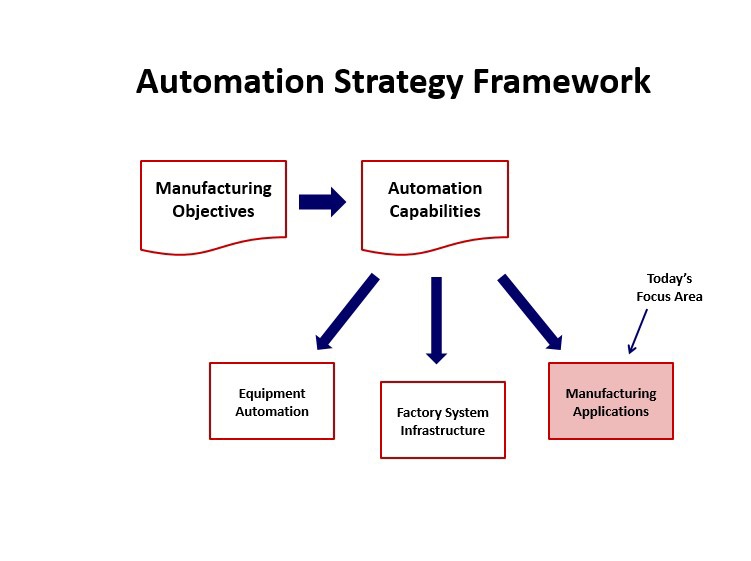In our November EDA-related blog, I covered highlights of the Factory System Infrastructure topic shown in the figure below, and emphasized the need to have a long-term architectural vision to guide the development of a scalable data collection and management environment. Today’s topic completes the picture by summarizing the kind of Manufacturing Applications that can leverage a factory-wide EDA implementation. Unlike infrastructure software alone, these applications are what really provide the ROI for the process engineers and other factory customers of the manufacturing IT department’s efforts, so it is important to understand the scope and requirements of these key applications early in the strategic planning process.

Even though Cimetrix is principally in the business of providing software products that enable equipment suppliers to provide data using EDA technology to the factory application developers that use the information in their production systems, we’ve been involved in this process for many years, and have a good idea of the dominant uses of this data to improve manufacturing Key Performance Indicators (KPIs). So in this blog, I’ll cover a little of the high-level picture of what applications fully leverage EDA data.
First and foremost, it is very easy to connect a basic EDA client to a piece of equipment, upload its metadata, and collect information about that tool’s behavior, so implementing a generic “quick-connect production monitor” independent from the fab-wide data collection system is a very common use for EDA. Moreover, if the model in the tool is compliant to the E164 (EDA Common Metadata) standard, you can make a lot of assumptions about the names of the modules, the wafers, the substrate locations, the process jobs, etc., since all of this information is standardized. As a result, you can quickly get an idea of what the equipment is doing, what recipes it is running, what wafers are being processed, and how well the tool is performing with no custom software whatsoever.
Once this is accomplished, the next step most process and equipment engineers take is to more fully characterize the tool’s behavior, so a very common use of EDA is simply improving equipment and process visibility. By inspecting the equipment model, you can see all the events and parameters that are available to be collected, plot them in Excel or on real-time strip charts, or pass them to other analysis applications.
After the equipment has been characterized, the first major production application most fabs will implement is multivariate fault detection (MVA FDC). This is actually the predominant application of EDA data in the industry to date, because in order to do well-architected fault detection applications, one must “frame” the trace data very carefully. High-speed data collection is usually only required in a small number of specific recipe steps after certain conditions have been established, so you can use EDA’s powerful event-based trace data collection to frame the precise data you want, and pass that on to the multivariate control and fault models.
Of course, once you understand a tool’s behavior and have good fault detection capability, you then start to use EDA data to compare tools across a fleet. You would normally want a set of similar equipment to behave in the same way, but perhaps you have one tool that performs exceptionally well, and you’re not quite sure why…In this case, you do what’s called a “golden run” analysis on that equipment, and compare the key trace variables in one with like variables in similar equipment to see where the differences are, and try to explain why those differences exist. Other names for this class of applications include chamber matching and tool matching.
Another key application that we’re starting to see significant interest in is external sensor integration. Factories are now starting to use EDA to present information collected from independent sensors alongside the information collected directly from the equipment. Sharing a common equipment model across these systems effectively “unifies” that data, so the downstream analysis applications believe the information was collected from a single, integrated source. The EDA metadata model offers an ideal way to accomplish this unification.
Finally, in many advanced wafer fabs, it is important that substrates do not “sit around” after they’ve been processed. Minimizing inter-process wait times is especially important for some advanced processes, so knowing a priori—the precise moment that a lot is going to complete—is a critical capability so the material handling systems can be scheduled to pick up that material and take it to the next process. EDA provides an ideal way to make these predictions generically for multiple process types using the information that is required in the equipment model.
We’ll address these last two applications—external sensor integration and lot completion estimation—in more detail in later blog postings, but I wanted to get you thinking about these ideas early in the discussion of real EDA usage in semiconductor factories.
There are many more EDA application ideas and examples we could share at this point, from component fingerprinting to wait-time waste analysis to dynamic sampling for wafer-level feedback control to feature extraction for predictive maintenance…but these just scratch the surface of what factory customers will come up with once they experience firsthand the flexibility and power of EDA in their factories. More later as this creative process unfolds!
To schedule a time to discuss your EDA needs, click here to set-up a time to talk with one of our knowledgable experts.♦




